IGUANAS
 蓝岩鬣蜥 |  白化病鬣蜥 |
|---|---|
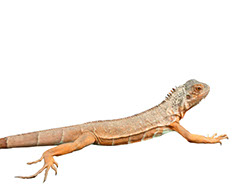 红鬣蜥 | 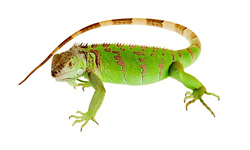 绿鬣蜥 |
鬣蜥护理工作表
大小: 成人鬣蜥的尺寸范围从四到六英尺的长度.
寿命: 如果护理得当,鬣蜥应该圈养生活 20 年以上.
总体外观: 鬣蜥是大多数人认为他们认为当 \'蜥蜴。他们每只脚上有五个脚趾。他们拥有称为赘肉的下巴皮肤肉瓣。所有鬣蜥都有运行背的长度的刺。相反,并不是所有的鬣蜥是绿色的。大多数青少年都是明亮的绿色,但随着他们年龄的增长他们可以范围的颜色从暗绿色至褐色,甚至橙色条纹的尾巴.
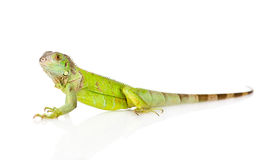
住房需求
附文: 一个成人的鬣蜥外壳是非常大的。盘柜应至少六英尺高,约 1 到鬣蜥,1 和 2 3 全长的鬣蜥宽的两倍长。对于六英尺的成人鬣蜥,这是封入物就是 9 到 12 英尺长,四到六英尺宽,和至少六英尺高。此外应提供足够分支和攀爬和懒洋洋的货架。给你观点的存储模块大小,最小的卧室,都是只有 9 英尺宽。这就是为什么很多业主奉献一个单独的房间,作为他们鬣蜥室。一些业主也允许他们对 \'自由的范围\' 的鬣蜥在房子里。如果你允许你的鬣蜥生活在自己的房间或自由的范围,一定要保持鬣蜥会频繁地区免费的鬣蜥可能意外地吞下的小对象。
温度: 鬣蜥来自热带的气候和需要保持温暖。白天温度应该是 80 ° ~ 85 ° F 白点晒太阳的 90 ° 到 95 ° f。应提供给鬣蜥,使它能够体温本身的温度范围。夜间温度应该是 75 °-80 ° f。所有的温度应定期验证用温度计.
光热: 提供 UVA 和 UVB 紫外线照明所需的适当的钙代谢和骨骼发育。没有适当的照明你的意志而生病和死亡的非常痛苦。可以利用日光灯管为特制的使用爬行动物以及汞蒸气灯泡,也提供一些热量以及提供适当的照明。利用红外辐射陶瓷器和晒太阳白炽灯,可以提供额外的热量。炽热的岩石应从不用作在任何情况下他们可以严重烧伤您的鬣蜥.

基材: 鬣蜥会经常用舌头舔他们的周围。因为这最微粒衬底 (刨花、 地膜、 砂或粉末类型) 并不适合大多数的鬣蜥。用无毒油墨、 屠夫的纸,纸巾,室内室外的地毯或人工草所有报纸做出很棒的选择。如果使用的室内室外地毯或人工草请务必有没有晃来晃去的字符串,可以在您的鬣蜥指甲纠缠不清。它还建议你有多个碎片,所以,你可能会弄脏的块替换清洁套然后清洗和消毒当前集以用于下一次清洗.
Environment: Iguanas come from a tropical climate and require a humidity level of 65% to 75%. To achieve this may require several misting’s a day. Many people opt to purchase an automatic misting system instead.
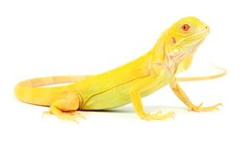
Diet: Iguanas are strict herbivores. Many older literatures will suggest feeding animal protein or even cat food. While some wild iguanas may ingest the occasional insect while eating leaves, it is not a significant portion on their diet. Iguanas that are fed too much animal protein will develop health problems and will die prematurely. A well balanced iguana diet will consist of about 40% to 45% greens (this includes, but is not limited to collard greens, turnip greens, mustard greens, dandelion greens (with flowers), escarole, and/or water cress), 40% to 45% other vegetables (this includes but is not limited to green beans, orange-fleshed squashes (butternut, Kabocha), snap or snow peas, parsnip, asparagus, okra, alfalfa (mature, not sprouts), onions, mushrooms, bell peppers, sweet potato, zucchini, yellow squash, and/or carrots), 10% or less of fruits (including, but not limited to Figs (raw or dried), blackberries, strawberries, raspberries, grapes, mango, melon (cantaloupe, honeydew, watermelon), papaya, banana, and/or apple), and less than 5% of other grains or commercial diets. Iguanas should never be rhubarb as it is toxic. Certain lettuces such as iceberg, romaine, and Boston butter lack sufficient nutrients and should only be fed occasionally. Acidic fruits (citrus, tomatoes, kiwi, pineapples, etc.) should also be only fed occasionally as well. Tofu can be occasionally offered as well for supplemental protein, though if too much is given it can lead to long term health issues. Wild plants and flowers are not recommended since they may be toxic to your iguana or may contain pesticides that could be toxic as well.
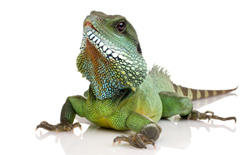
Maintenance: Cleanliness of the enclosure is essential. Waste products should be removed daily and the enclosure should be thoroughly cleaned and disinfected regularly. A 5% bleach solution provides an excellent disinfectant. Be sure to thoroughly rinse the solution from the enclosure before placing the iguana back in. Fresh water should also be offered at all times. Always wash your hands after handling your iguana or any of your iguana\'s cage accessories.